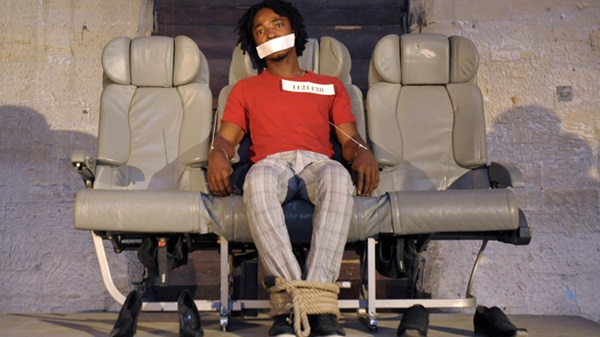Art & Exhibitions
Protests Turn Violent Over Controversial Exhibit B Performance in Paris


David Ebony


An actor performing in Brett Bailey’s Exhibit B at the 2013 International Theater Festival of Avignon.
Photo: Frank Pennant/AFP Photo.
South African artist Brett Bailey caused an uproar again last week when he tried to stage a performance of his controversial Exhibit B at the Théâtre Gérard Philipe in Saint-Denis, near Paris. The work features a dozen performers silently mimicking the “human zoos” that circulated in 19th- and early 20th-century Europe. In the work, performers, some representing certain African tribes, are posed like animals for the amusement of onlookers, as they did in the original “human zoo” exhibitions.
As reported in the New York Times, RT and elsewhere, some 200 protesters, some holding holding signs reading “No to Human Zoos!,” decried the piece as racist, broke barricades, smashed windows, and tried to prevent visitors from entering the theater, causing last Thursday’s performance to be halted.
Bailey, who is white, claims that the Exhibit B, which is part of a series, is not racist and is actually meant to be an anti-apartheid statement, and presented one reaction on his Facebook page on Saturday, November 29 (edited for length):
. . . In EXHIBIT B I investigate the way in which black people have been represented, objectified and dehumanized by racist systems in order to indoctrinate people; the way in which these racist systems continue to operate today, here in Europe; around the world. / I choose to portray black people in objectified form to demonstrate the violence of these systems. I opt to perform the work in utter silence, to emphasize how the voices of the colonized, the marginalized, the subjugated, are stifled. . . .
I ask [the performers] to envision themselves as the spectators in this exhibition, gently watching the audience grapple with the horror of realizing the brutality of such a system. I want them to explode from the inside the stereotype of the passive, victimized black body. / But out there on the floodlit street, beyond the barricades, this is not understood. Those people have not attended the performance. . . .
I regret that a multidimensional performance piece, which has meaning in the intimate dynamic interaction between performers and spectators, has been judged on the basis of 2-dimensional photographs. / I acknowledge that seeing a photograph of a shackled black woman and reading that it is the work of a white South African man can cause deep offence. / I wish that photographs of EXHIBIT B had not been published, and that the only access that people had to the work is through the living, vibrating, profound experience of recognizing the equality and humanity in us all, and the horrors of systems that continue to stifle this.
The 12-tableaux work has caused a trail of controversy for some time since its debut several years ago, as JJ Charlesworth reported in artnet News (see “Exhibit B Might Be Offensive to Some But That’s No Reason to Close It Down.” (Bailey also issued a response to the cancellation of the show in London.)
Not all observers are opposed to the work. As reported by L’ Obs and others, some French historians and scholars are defending Exhibit B, and in France, it has the support of the League of Human Rights, the Paris mayor, and culture minister Fleur Pellerin, who condemned the storming of the theater and described the actions of the protesters as “attempts at intimidation and censorship.”